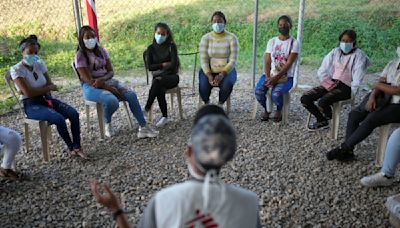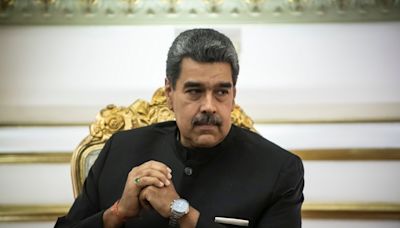Search results
Venezuela, [a] officially the Bolivarian Republic of Venezuela, [b] is a country on the northern coast of South America, consisting of a continental landmass and many islands and islets in the Caribbean Sea. Venezuela comprises an area of 916,445 km 2 (353,841 sq mi), and its population was estimated at 29 million in 2022. [13]
- President of Venezuela
The president of Venezuela (Spanish: Presidente de...
- 2019 Presidential Crisis
The Venezuelan presidential crisis was a political crisis...
- Venezuelan Bolívar
The notes are printed by Casa de la Moneda Venezuela in...
- Caracas
Caracas (/ k ə ˈ r æ k ə s,-ˈ r ɑː k-/, Spanish:),...
- Flag
The current eight-star flag of Venezuela was introduced in...
- Demographics of Venezuela
According to the 2022 revision of the World Population...
- Afro-Venezuelan
Afro-Venezuelans (Spanish: Afrovenezolanos) are Venezuelans...
- Bolivarian Diaspora
History. During the 20th century, "Venezuela was a haven for...
- Politics of Venezuela
The politics of Venezuela occurs in a framework explained in...
- National Bolivarian Armed Forces of Venezuela
The National Bolivarian Armed Forces (Spanish: Fuerza Armada...
- President of Venezuela
- Overview
- Land
- Relief
Venezuela, country located at the northern end of South America. It occupies a roughly triangular area that is larger than the combined areas of France and Germany. Venezuela is bounded by the Caribbean Sea and the Atlantic Ocean to the north, Guyana to the east, Brazil to the south, and Colombia to the southwest and west. The national capital, Caracas, is Venezuela’s primary centre of industry, commerce, education, and tourism.
Venezuela administers a number of Caribbean islands and archipelagos, among which are Margarita Island, La Blanquilla, La Tortuga, Los Roques, and Los Monjes. Since the early 19th century Venezuela has claimed jurisdiction over Guyanese territory west of the Essequibo River totaling some 53,000 square miles (137,000 square km)—nearly two-thirds of the land area of Guyana. Venezuela also has had a long dispute with Colombia over the delimitation of maritime boundaries in the Gulf of Venezuela and around the archipelago of Los Monjes.
A physiographically diverse country, Venezuela incorporates the northern Andean mountain chains and interior highlands, the main portions of the Orinoco River basin with its expansive Llanos (plains), Lake Maracaibo, which is the largest lake in South America, and the spectacular Angel Falls, the world’s highest waterfall. The republic’s development pattern has been unique among Latin American countries in terms of the speed, sequence, and timing of economic and demographic growth. In the 20th century Venezuela was transformed from a relatively poor agrarian society to a rapidly urbanizing one, a condition made possible by exploiting huge petroleum reserves. These changes, however, were accompanied by imbalances among the country’s regions and socioeconomic groups, and Venezuela’s cities swelled because of a massive and largely uncontrolled migration from rural areas, as well as mass immigration, much of it illegal, from Colombia and other neighbours.
Venezuela, like many other Latin American countries, has a high percentage of urban poverty, a massive foreign debt, and widespread governmental patronage and corruption. Venezuela’s social and political ills have been compounded by natural disasters such as the floods that devastated sections of Caracas, La Guaira, and other coastal areas in late 1999. On the other hand, from 1958 to the early 21st century the republic was more democratic and politically stable than most other Latin American nations, and its economy benefited from a thriving petroleum industry that capitalized on the world’s largest known oil reserves. Venezuela’s position in the world became more precarious during the second decade of the 21st century as a result of the controversial rule of revolutionary leader Hugo Chávez, a significant decline in the fortunes of its petroleum industry, and the increasing authoritarianism of Chávez’s successor, Nicholás Maduro.
Britannica Quiz
Which Country Is Larger? Quiz
The Venezuelan landscape includes towering mountains, tropical jungles, broad river plains, and arid coastal plains, all of which provide a diversity of natural habitats and a range of challenges to social integration and economic development.
Venezuela’s topography can be divided into three broad elevational divisions: the lowland plains, which rise from sea level to about 1,650 feet (500 metres), the mountains, which reach elevations of some 16,400 feet (5,000 metres), and the interior forested uplands, with scattered peaks above 6,550 feet (2,000 metres). Within these broad divisions, seven physiographic regions can be distinguished: the islands and coastal plains, including the Orinoco delta; the Lake Maracaibo Lowlands; the Mérida and Perijá ranges of the Andes Mountains; the coastal mountain system (with its Coastal and Interior ranges); the northwestern valleys and hill ranges, also called the Segovia Highlands; the Llanos; and the Guiana Highlands.
Students save 67%! Learn more about our special academic rate today.
Learn More
The islands and coastal plains are located in the north. They include the Caribbean “Islands to the Leeward,” such as Margarita and La Tortuga, and several peninsulas, including the head-shaped Paraguaná in the northwest and, in the northeast, Araya and Paria, the latter a finger of land pointing at Trinidad. The coastal plains extend from the Colombian border and the Gulf of Venezuela eastward to the foothills of the coastal mountains, which are broken in the east by the Unare River basin. Farther east is the Orinoco delta, which opens onto the Atlantic Ocean through a number of distributaries (caños); an early gateway to the settlement of the interior, it is a low, dank, and swampy area heavily dissected by streams.
The two branches of the Andes that traverse northwestern Venezuela, including the country’s highest peaks, are northeastward extensions of the Colombian Andes’ Cordillera Oriental. The western branch, known as the Perijá Mountains (Sierra de Perijá, or Serranía de los Motilones), runs along the border with Colombia, whereas the eastern branch, the Cordillera de Mérida, extends from the border to Lara state and divides the Lake Maracaibo basin from that of the Orinoco River. Physiographically, the Segovia Highlands, northwest of Barquisimeto, and the coastal ranges may also be considered parts of the Andes chain. The highest point in the Venezuelan Andes is Bolívar Peak (La Columna), which rises to 16,332 feet (4,978 metres) in the Cordillera de Mérida. Between the high Andean ranges are Lake Maracaibo and its associated lowlands; this basin is one of the main oil-producing regions of the country.
The coastal mountain system, in effect two parallel ranges—the Coastal Range and the Interior Range—contains Venezuela’s greatest concentration of population, although it covers only a tiny fraction of the national territory. In the intermontane valleys are the major cities of Caracas, Valencia, and Maracay, and all but the steepest slopes are populated. Naiguatá Peak, at 9,072 feet (2,765 metres), is the highest point in the coastal system.
Venezuela, officially the Bolivarian Republic of Venezuela, is a country on the northern coast of South America, consisting of a continental landmass and many islands and islets in the Caribbean Sea. Venezuela comprises an area of 916,445 km2 (353,841 sq mi), and its population was estimated at 29 million in 2022. The capital and largest urban agglomeration is the city of Caracas.
The Province of Venezuela in 1656, by Sanson Nicolas. One of the first maps about Venezuela and near regions. 5 July 1811 (fragment), painting by Juan Lovera in 1811.. The history of Venezuela reflects events in areas of the Americas colonized by Spain starting 1502; amid resistance from indigenous peoples, led by Native caciques, such as Guaicaipuro and Tamanaco.
People also ask
What is the history of Venezuela?
Is Venezuela a country?
Where is Venezuela located in South America?
What is Venezuela known for?
Venezuela is a country in northern South America. Its official name is República Bolivariana de Venezuela (Bolivarian Republic of Venezuela). The official language is Spanish, and the capital is Caracas . The country has a wide range of geography including islands in the Caribbean Sea, coastal areas, highlands, and parts of the Andes Mountains.
Venezuela’s position in the world became more precarious during the second decade of the 21st century as a result of the controversial rule of revolutionary leader Hugo Chávez, a significant decline in the fortunes of its petroleum industry, and the increasing authoritarianism of Chávez’s successor, Nicolás Maduro. Venezuela.
The economy of Venezuela is based primarily on petroleum. [4] [18] Venezuela is the 25th largest producer of oil in the world and the 8th largest member of OPEC. Venezuela also manufactures and exports heavy industry products such as steel, aluminum, and cement. Other notable manufacturing includes electronics and automobiles as well as ...




